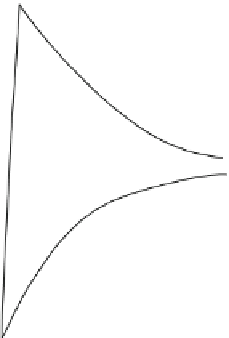Geoscience Reference
In-Depth Information
˕
2
x
1
Fig. 8.2
An approximate dependence of electric potential on distance near the capillary wall.
1
—Usual character of the dependence;
2
—A case when the total charge of ions adsorbed by the
capillary wall and of hydrated ions is positive
layer and the DEL boundary (or the capillary axis). In Fig.
8.2
, in one case the
&-potential is negative (curve 1) and in the next one it is positive (curve 2).
The moving fluid drags the ion excess contained in the bulk fluid thereby exciting
the convective current of ions. This gives rise to the formation of both the potential
difference between the ends of capillary and the electric field which in turn result in
the generation of the reverse electric current that compensates the convective current
of ions.
We now consider a laminar flow of viscous fluid in a cylindrical channel with
constant radius r
0
. The projection of fluid velocity V
x
on the channel axis x is
described by Poiseuille formula
r
0
r
2
4
dP
dx
;
V
x
D
(8.2)
where is the viscosity coefficient of the fluid, P is the pressure in the fluid, and
r is the radius counted from the channel axis. Since Debye radius r
D
is small, that
is, r
D
r
0
, the DEL can be considered as a narrow layer. The number density
of mobile ions is maximal in the vicinity of the external DEL boundary; that is,
near the surface of channel. In this region we can use the following approximation:
r
0
r
2
2r
0
y where y
D
r
0
r. Here we dwell on the simple model which assumes
the non-conducting channel walls and conducting fluid. The electric potential dž in
the fluid obeys Poisson equation
























Search WWH ::

Custom Search